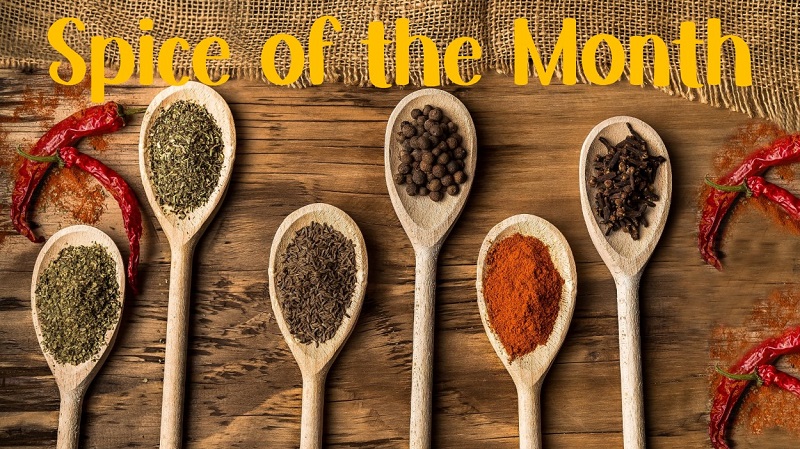Coffey County Library and the K-State Extension Office have teamed up to promote healthy cooking while exploring new herbs and spices! Participants will receive a packet with new spices to try each month plus two recipes featuring that spice and a little history about it. The Spice of the Month will also be featured on the Coffey County Library calendar each month.
To receive the materials, please register online at https://bit.ly/CoffeyCountySpiceoftheMonth, by scanning the QR code below, or drop by any of the Coffey County Library branches.
History of Herbs and Spices
Herbs are fresh and dried leaves that are typically green in color. Spices are flowers, fruit, seeds, bark, and roots from tropical plants that have a wide variety of colors. Spices are more pungent in flavor than herbs and are therefore used in smaller amounts. Herbs and spices have been used for centuries to season and add flavor to foods. They were also used for medical purposes. Before the invention of the modern-day refrigerator, herbs and spices helped reduce the growth of bacteria in foods.
Recent evidence points to added health benefits when using herbs and spices. Both have antioxidant and antiinflammatory properties and have cancer-preventative and cancer-fighting components. Herbs and spices are flavorful alternatives to salt, fat, and sugar that do not add unwanted calories to meals.
Storing Herbs and Spices
The flavors of herbs and spices are fragile and can be destroyed by heat, light, and moisture. Seasonings should be stored in tightly covered containers in a cupboard or drawer. Store them away from heat and moisture sources such as the dishwasher, sink, range, or heating vent. In hot climates, refrigerate paprika, chili powder, and red pepper to protect flavors.
Most people keep seasonings too long and they surpass the “Best if Used By/Before” date. To determine a flavoring’s quality, crush or rub a small amount in your hand to see if it smells strong and flavorful. Generally, spices and herbs should be kept for a year or less. Write the date on the seasoning container when you bring it home from the store before placing it in your cabinet.
Healthier Seasonings
Reducing Sugar: Diets high in sugar contribute to obesity, hypertension, elevated triglycerides, and heart disease. Although sugar is a tasty ingredient, it adds little nutritional value to foods and can cause adverse health problems. Over the past several decades, our taste buds have been trained to crave sweet flavors but they can be re-trained to crave healthier, more savory flavors over time. Adding spices such as allspice, anise, cardamom, or cinnamon will help add flavor and reduce the amount of sugar needed to make a recipe sweet.
Reducing Salt/Sodium: A large intake of salt regularly is associated with high blood pressure and heart disease. Replace salt in savory preparations with black pepper, garlic powder, curry powder, cumin, dill seeds, basil, ginger, coriander, or onion powder. Be sure to check the ingredient label of seasoning mixes to ensure that salt is not the first added ingredient.
Reducing Fat: A diet high in solid (saturated) fats is linked to cardiovascular disease and can cause strokes. Foods high in fat contain cholesterol, which can increase our levels when consumed and contribute to the risk of heart disease. Other risks with high fat intake include obesity, diabetes, breathing problems, and trouble sleeping. Eating foods lower in fat can reduce calories and decrease the risks of heart disease and some cancers. Using herbs and spices for flavoring instead of breading, batters, gravies, or sauces is a healthier preparation method.
Seasoning Amount Guidelines
Use the following to determine how much herb or spice to use (Stephens, 4):
Equivalent amounts: 1 tablespoon finely cut fresh herbs = 1 teaspoon crumbled dried herbs = ¼ to ½ teaspoon ground dried herbs.
Begin with a small amount and adjust as needed. For 4 servings or 1 pound of meat or 1 pint/2 cups of soup or sauce, use ¼ teaspoon of
dried ground herbs.
When doubling a recipe, do not double herbs and spices. Increase amounts by 50 percent, adding more if needed.
Add less delicate herbs (such as dill seed, oregano, and thyme) earlier in the cooking and more delicate herbs (such as basil, chives, and mint) later or just before serving.
References and Resources
Stephens, Jan. “Seasoning with Herbs and Spices.” Food, Nutrition, Dietetics and Health | Research and Extension | Kansas State University, K-State Research and Extension, July 2010,
https://www.ksre.k-state.edu/fcs/agent-resources/lesson-series/fcs-lessonseries/MF2921%20seasonsing%20with%20herbs%20and%20spices%20leaders%20guide.pdf
McAlpine, Meg. “Herbs and Spices and Health Benefits.” UF/IFAS Extension Nassau County, 20 Feb.2020, https://blogs.ifas.ufl.edu/nassauco/2019/08/26/herbs-and-spices-and-health-benefits/
Sánchez, Elsa. “Herb and Spice History.” Penn State Extension, https://extension.psu.edu/herb-and-spice-history


